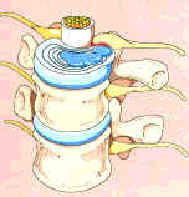The intervertebral dics are little pads that lie between the vertebrae; each disc has a tough outer ring (annular fibrosis) and a soft gel-like center (nucleus pulposis).
The discs separate the vertebrae and, because theyíre knitted into the bones, also join them together. They act like little shock absorberís, cushioning the bones so that they donít crash against each other as we walk, which would be very painful. Discs help give the spine its curve, flexibility, and strength. The 23 discs in our spine also make up about 1/3 of the length of the spinal column and thatís why we are about a quarter-inch to a half-inch taller in the morning than we were the night before; the discs flatten out a little after a day of standing and then regain their volume when we sleep.
| There are two types of herniations: Protrusions and Prolapses. A protrusion can occur if the nucleus pulposis bulges, pushing the annular fibrosis out of shape. A prolapse occurs if the nucleus bulges out so much that it actually separates from the rest of the disc. If the prolapsed disc goes into the spinal cord or puts pressure on nerves, it may cause severe pain that could make sitting, standing, walking, lifting, urinating, defecating, sneezing, coughing and moving nearly impossible. In extreme cases, foot or leg numbness or a loss of muscle control may occur. Fewer than 5 percent of those with low-back pain have any disc problems. |
|
While spinal surgery is sometimes necessary, especially in cases of trauma or severe bone, disc, and nerve destruction (due to variety of causes, from infection to cancer), the vast majority of people with low-back pain and/or sciatica never need it.
Of this 250,000 surgical procedures done each year for ruptured discs, medical authorities admit that 50 to 90 percent are unnecessary and useless. Up to 53 percent of those who have back surgery are in the same or worse pain after the operation. They have Failed Back Surgery Syndrome (FBSS). To make matters worse, if surgery is ineffective the first time, a second or third operation will not help. Even successful operations cause scar tissue, permanent spinal weakness, distortion, and instability. Now researchers believe disc herniation may not be such a serious problem after all! Recent studies show that about 40 percent of all people over age 40 have disc herniations but are walking around pain-free and healthy, and by age 75 that figure becomes 80 percent. In light of those facts, it should come as no surprise that one medical authority has admitted, "All in all, it has been universally acknowledged that the medical approach to back pain has been an expensive failure." Chiropractic could save many thousands of back-pain sufferers from unnecessary spinal surgery each year. Anyone facing the prospect of spinal surgery should, if possible, get at least one opinion from a doctor of chiropractic before deciding what to do.
Conditions
Treated | Subluxation Complex | Subluxation
Degeneration
Neck | Headache | Shoulder
| Back | Disc | Sciatica
Pregnancy | Kids
| Sports




